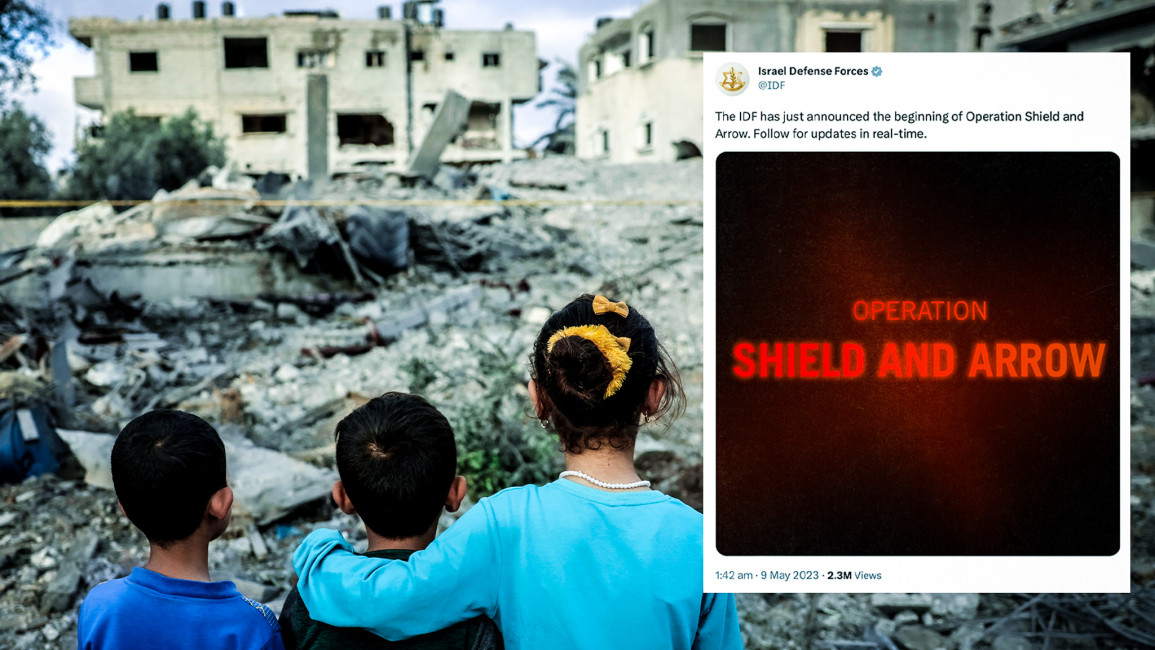
Decoding the Israeli army's propaganda techniques
Propaganda, in all its forms, has been used to shape public opinion and advance specific narratives throughout history. In this era of social media dominance, the Israeli Occupation Forces (IOF) has adapted its old propaganda strategies to the digital landscape.
During the last attack on Gaza in May, which the IOF called ‘Operation Shield and Arrow’, the IOF’s official Twitter page was used extensively for live updates, alerts and cinematic productions of its ‘operation’.
But under the surface of aesthetic visuals and persuasive messaging lies a complex web of manipulation and power dynamics at play. When examining the carefully constructed facade, we witness the paradoxical spectacle of an army proclaiming its moral superiority while simultaneously targeting Palestinian civilians in their homes.
With chilling precision, the IOF not only live-tweets their attacks, but also designs visually captivating content, all in an attempt to justify their operations as defensive responses instead of offensive provocations.
"When military propaganda portrays Palestinian civilians as threats, it normalises the use of violence against them. This leads to the desensitisation of the suffering and loss of Palestinian lives"
In a stroke of irony, Twitter audiences were introduced to the name ‘Operation Shield and Arrow’ with a black and red design that looks like it could be the ending of a thriller movie trailer. With this name, Twitter users will likely envision a mythological shield, bravely guarding against all harm, while arrows soar with impeccable precision.
The name sidesteps the Israeli occupation of Palestinian land, the inherent inequality in power dynamics between occupier and occupied, and the countless lives destroyed by the operation, which killed 33 Palestinians and injured more than 100.
The ingenuity of a name like ‘shield and arrow’ is in how deliberately and effectively it masks the disproportionate use of force and disregard for human lives by the Israeli military. This is one of the symptoms of military propaganda - sugarcoating the bloody reality with an appealing name.
Another cinematic video posted by the IOF features Islamic Jihad militants with powerful visuals and impressive editing. Islamic Jihad leaders and militants are seen delivering speeches emphasising their desire to destroy Israel, juxtaposed with images of Israelis running from danger.
For 75 years Israel has refined its propaganda, portraying itself as ‘democratic’ & ‘tolerant’ of all faiths whilst omitting and re-writing the ethnic cleansing of Palestinians. This only reinforces the state's insecurities, argues Sarah Amr ⬇ #Nakba75https://t.co/asJwycViGn
— The New Arab (@The_NewArab) April 28, 2023
The cinematic production value of the video aims to captivate viewers by using auditory and visual elements to evoke strong emotions. Ultimately, videos like this are designed to provide a one-sided, warped portrayal of the Israeli occupation while oversimplifying or entirely erasing the wider political and historical context.
The timing of the video’s release on the first day Israel’s latest assault on Gaza suggests a deliberate effort to shape public opinion and frame the operation as a necessary response to the perceived threat from Islamic Jihad rather than a systematic Israeli practice of bombing innocent civilians in the world’s largest open-air prison.
This reinforces the narrative of self-defence and the need to protect Israeli civilians at all costs - a theme which emerges among all tweets during the period of the offence - while completely erasing the underlying causes of Palestinian resistance: decades of occupation, the blockade of Gaza and the systematic oppression of Palestinians.
Another theme that emerges from the set of tweets published during the attack is the dehumanisation and normalisation of violence towards Palestinians. Palestinians who are killed by the IOF are denied their right to privacy and dignity in death. Instead, their faces are plastered across Twitter in updates celebrating the murder of those affiliated with Islamic Jihad.
These tweets, which depict pictures of these men alongside a red backdrop and bold white text resembling a combat video game, portray the targeted individuals as mere figures of menace and danger, conveniently stripping them of their humanity and reducing them to mere threats.
The wording of the sentences is concise, direct and uses strong language. Phrases like “directly responsible”, “imminent threat” and “central figure” create a sense of urgency. This type of language aims to evoke a strong emotional response (evident in the comment section) and solidify support for the IOF’s actions.
Of course, the children and women who went to sleep and never woke up are not featured on the IOF’s Twitter page at all. This selective representation of events is another symptom of military propaganda, which downplays and omits certain and reference to civilian deaths.
When military propaganda portrays Palestinian civilians as threats, it normalises the use of violence against them. This leads to the desensitisation of the suffering and loss of Palestinian lives. The repeated exposure to dehumanising narratives creates an environment where acts of violence against Palestinians are seen as acceptable or even necessary.
Not only do the tweets aim to justify crimes against humanity by portraying heinous acts under an illegal occupation as ‘self-defence’, thereby dehumanising Palestinians and normalising violence against them, they also appeal to nationalism and patriotism.
Military propaganda evokes nationalistic sentiments and appeals to patriotism to attract support for military actions. Ultimately, IOF’s messaging emphasises the defence of the Jewish homeland and the protection of the Jewish Israeli citizens, messaging that resonates deeply with those who have bought into Zionist propaganda.
The influence of these tweets on readers, especially those unaware of the accurate historical and current context, can be significant in shaping their perception regarding the Palestinian cause.
By crafting a narrative that conveniently overlooks the nuances of the Palestinian struggle, the IOF succeeds in rendering the uninformed to stay silent and apathetic towards the plight of Palestinians, creating a culture where violence is normalised and empathy is eroded.
Sarah Amr is a Palestinian writer interested in media discourse and liberation movements. She holds a Bachelor of Arts in Media and Communications from the University of Sussex.
Have questions or comments? Email us at: editorial-english@newarab.com
Opinions expressed in this article remain those of the author and do not necessarily represent those of The New Arab, its editorial board or staff.




